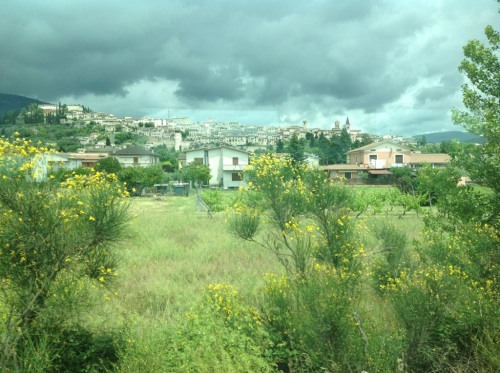Tivoli
Hey everyone!
I am currently posting from the beautiful medieval town of Assisi! I did something very European and spur-of-the-moment and took a train to a different city, am staying at a bed-and-breakfast and then going to Rome tomorrow afternoon. I’m not a horribly spontaneous person, and believe it or not, this was my idea!
All of us students were on a bus from the beautiful town of Tivoli (more on that later) and someone mentioned Assisi. Since I had no plans for the weekend, I said, “why not go?” On that very bus, in the next half an hour, we made plans to go the next day. I even called a hotel and inquired about prices and rooms and stuff in complete Italian. This is not as easy as it sounds, I have to tell you.
I’ll post separately about Assisi. For now, I’ll tell you a bit about Tivoli.
The field trip yesterday was draining and fulfilling. We all met bright and early to go to Tivoli to see the ruins of Hadriun’s palace. The guide spoke to us in only Italian and helped us picture the beautiful ruins. To be honest, the most memorable thing she spoke about was Hadrien’s twelve-year-old lover (Hadrien was like 50s-60s at when they met). Hadrien loved him so much that he took the young boy everywhere he went and dedicated many palaces (apparently he had the strange habit of building gorgeous palaces and never really occupying them) and even towns to him. Then, when the boy was 18, he mysteriously died somehow in the Nile. It’s such a good story.
Then we had lunch at Tivoli. A lot of students did what they usually do, and searched for the cheapest panino or pizza they could find. However, my two friends Marina and Daniela and I stumbled upon a family-owned restaurant of which I can’t remember the name. It was our first Italian restaurant experience. (For those of you who, like me, didn’t know, there’s a sort of chain of command for Italian eateries. There are caffes, bars, trattorias, osterias and finally restaurants.) My Italian host mother had been training me for this all week, instructing me on the proper dining etiquette of the Italians (incredibly complex, if you ask me.)
I ordered tagliatelle in an olive oil sauce with zucchini blossom, zucchini peel, fresh buffalo mozzarella and parmigiano. It sounds a lot more boring than it was, I assure you, since fresh pasta doesn’t need much to shine. Additionally, I had been wanting to try zucchini blossom for at least three years now, but since it is such a rarity, I have never been able to.
Marina ordered ricotta ravioli with the most intriguing sauce of walnuts, cream, and I believe wine and Daniela ordered a fritti misti of frutti di mare, a mixed seafood plate. Interestingly, bread was free, usage of the bathrooms was free, but they charged a 1.5 euro (each) sit-down fee (contorno) and also 2.5 euro (total) for water.
After lunch, we trekked over to the beautiful Villa d’Este, the home of a historically very powerful family. In direct contrast to the ruins, most parts of the home were beautifully preserved (some, like the violent art room whose theme was hunting, was too well-preserved, if you ask me) but the gardens were ethereal. There were so many beautiful working fountains, surrounded with aranciata, or orange, trees and jasmine flowers and tulips that I could not believe that it was real. I literally could not imagine how one family could live at such a heavenly place, and one student rightly said it reminded her of Versailles. I think the villa was the most beautiful thing I have ever seen in my life. When I told this to my host mother, she laughed and said that I must not have seen many beautiful things. Perhaps she’s right, or unbelievably blessed to be surrounded by beautiful things all the time, but this was not an exaggeration.
I am so grateful I have a fabulous professor and program to take me to places like that because, to be honest, a villa doesn’t sound as exciting and outer-worldly as I can convey, and I am doubtful I would have gone without them.

